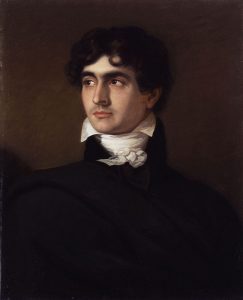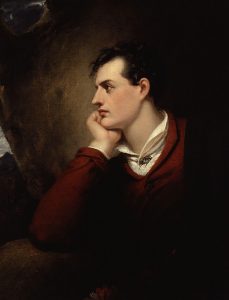 John William Polidori (7 September 1795 – 24 August 1821) was an English writer and physician. He was best known for his involvement in the Romantic movement, an artistic, literary, musical, and intellectual movement that originated in Europe toward the end of the 18th century. He is considered by many as the originator of the vampire genre of fantasy fiction. His most successful work was the short story “The Vampyre“ (1819), which was the first published, modern vampire story.
John William Polidori (7 September 1795 – 24 August 1821) was an English writer and physician. He was best known for his involvement in the Romantic movement, an artistic, literary, musical, and intellectual movement that originated in Europe toward the end of the 18th century. He is considered by many as the originator of the vampire genre of fantasy fiction. His most successful work was the short story “The Vampyre“ (1819), which was the first published, modern vampire story.
Perhaps because John Polidori was a physician, he was able to bring all the disparate elements of 19th-century vampirism mythology into a coherent, compelling short story. With just that one short story, he spawned an entire literary genre.
How did this come about? The story had its genesis in the summer of 1816, the Year Without a Summer when Europe and parts of North America underwent a severe climate abnormality.
Lord Byron and his young, twenty-year-old physician, John Polidori were staying at the Villa Diodati by Lake Geneva.
On the run from creditors and Shelley’s ailing, understandably jealous wife, Percy Bysshe Shelley, Mary Wollstonecraft Godwin (who later became Mary Shelley) and Claire Clairmont, Mary’s stepsister, visited them.
The group was kept indoors by the incessant rain of that cold, wet, unpleasant summer during a three-day stretch in June. Bored at being cooped up, the five turned to telling fantastic tales, and which inspired them to write their own.
Reportedly, they were fueled by ghost stories such as the Fantasmagoriana, William Beckford’s Vathek, and laudanum, to which Byron was addicted. Mary Shelley, in collaboration with Percy Bysshe Shelley, produced what would become Frankenstein or The Modern Prometheus.
Polidori was the outsider, the man who was only included as he was in the employ of Byron. Lord Byron made him the butt of many jokes at dinner parties, taking great pleasure in humiliating him. This cruel treatment of anyone in his power was well documented by his contemporaries.
 Polidori was inspired by a fragmentary story of Byron’s, Fragment of a Novel (1816), which is also known as “A Fragment” and “The Burial: A Fragment.” Over the course of several mornings, he wrote “The Vampyre.” The manuscript was overlooked for three years when it was discovered by a disreputable publisher, Henry Colburn. He published it in his New Monthly Magazine under the title “The Vampyre: A Tale by Lord Byron.” It was received with acclaim, much to Polidori’s surprise and chagrin.
Polidori was inspired by a fragmentary story of Byron’s, Fragment of a Novel (1816), which is also known as “A Fragment” and “The Burial: A Fragment.” Over the course of several mornings, he wrote “The Vampyre.” The manuscript was overlooked for three years when it was discovered by a disreputable publisher, Henry Colburn. He published it in his New Monthly Magazine under the title “The Vampyre: A Tale by Lord Byron.” It was received with acclaim, much to Polidori’s surprise and chagrin.
Polidori struggled to assert his rights to the work, and Lord Byron did have the grace to declare promptly the work was Polidori’s and not his. Despite that assertion, proper credit for authorship of the story was muddy for many years.
Still, Byron was firm that he was not the author. Apparently, Byron felt that the destruction of a man’s soul was no great thing, but theft of his intellectual property was a crime.
Polidori’s work had an immense impact on his contemporary readers. Numerous editions and translations of the tale were published. The influence of The Vampyre as described by Polidori has continued into the twenty-first century, as until recently, his work was frequently considered the primary source of what is accepted as “canon” when writing about vampirism.
What are the traditional tropes of vampire fantasy? First of all, we must think Lord Byron. He was an arrogant, self-centered, charismatic sociopath with a gift for writing brilliant poetry. From birth, Byron suffered from a deformity of his right foot, and by the time he hired Polidori, he was addicted to laudanum which had been prescribed for the pain. He treated the young Polidori atrociously, engendering deep antipathy for his patient in the young doctor.
Within the pages of Polidori’s diary, I see “The Vampyre” as an allegory of Byron’s abuse of John Polidori himself. It is easy to visualize Byron as a man possessed of the power to drain one of their soul when seen through the eyes of the man he had in his power, and whom he treated abominably as an employer.
Byron was described as the devourer of souls in the book, Glenarvon, by Lady Caroline Lamb, one of Byron’s former lovers. “Ruthven” is the name Lady Caroline Lamb referred to Byron as in her novel. Polidori had read Glenarvon that summer, and blatantly used Lamb’s protagonist’s name for his vampire, and Byron proudly admitted he was the role model.
The Public Domain Review article, The Poet, the Physician and the Birth of the Modern Vampire, says this about the rocky relationship between Polidori and Byron:
“It was no great leap for Polidori to believe that Byron was sucking the life from him, just as others had accused Byron of possessing a charismatic power that eclipsed their own identities. Amelia Opie, one of the many women Byron had charmed, described him as having “such a voice as the devil tempted Eve with; you feared its fascination the moment you heard it,” a mesmeric quality that critics also found in his verse, which had, according to the critic Thomas Jones de Powis, “the facility of…bringing the minds of his readers into a state of vassalage or subjection.”
 So we know vampires are charismatic and seductive. Their bite would enslave their victims. Folktales from hundreds of years ago tell us they can take the form of bats and fly through the windows of even the tallest buildings. Historically, vampires are powerful, but unable to withstand the light of day, which would burn them, and destroy them forever.
So we know vampires are charismatic and seductive. Their bite would enslave their victims. Folktales from hundreds of years ago tell us they can take the form of bats and fly through the windows of even the tallest buildings. Historically, vampires are powerful, but unable to withstand the light of day, which would burn them, and destroy them forever.
However, that which was once canon regarding vampires is no longer set in stone.
Modern vampires are often able to stay outside during the day, and some even sparkle. Many are model citizens who get their blood from robbing blood banks.
But underneath it all, I still have a fondness for the mad, bad, dangerous-to- know Lord Byron style of vampire.
~~~|~~~
Myrddin offers several varieties of Vampire for your reading pleasure:
Carlie M. A. Cullen’s Heart Search Trilogy
Stephen Swartz’s dark Stefan Szekely Trilogy
Nicole Antonia Carros’s hysterically funny Brawn Stroker’s Dragula
Credits and Attributions
Polidori’s Vampyre by Connie J. Jasperson was first published on her blog, Life in the Realm of Fantasy, on 20July, 2016, under the title Physician to the Vampyre. Reprinted by permission.
